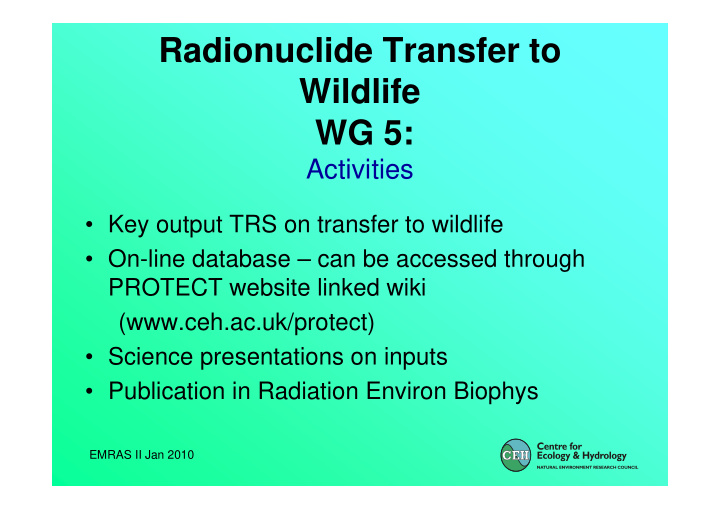



Radionuclide Transfer to Wildlife WG 5: Activities • Key output TRS on transfer to wildlife • On-line database – can be accessed through PROTECT website linked wiki (www.ceh.ac.uk/protect) • Science presentations on inputs • Publication in Radiation Environ Biophys EMRAS II Jan 2010
TRS: RADIONUCLIDE TRANSFER TO WILDLIFE Provide IAEA Member States with data for use in the radiological assessment of wildlife as a consequence of routine discharges of radionuclides to the environment and existing contamination situations. EMRAS II Jan 2010
EMRAS II Jan 2010
Database output EMRAS II Jan 2010
With sources… EMRAS II Jan 2010
Can elemental composition data of crop leaves be applied to tree leaves and wild grass? K. Tagami & S. Uchida, NIRS, Japan Concentrations of elements in Herbaceous plants, mg/kg Concentrations of elements in Herbaceous plants, mg/kg 6 6 10 10 Herbaceous plants Rice leaves 4 4 10 10 2 2 10 10 0 0 10 10 -2 -2 10 10 -4 -4 10 10 -4 -2 0 2 4 6 -4 -2 0 2 4 6 10 10 10 10 10 10 10 10 10 10 10 10 Elemental concentraiton in leafy vegetables, mg/kg Elemental concentraiton in leafy vegetables, mg/kg EMRAS II Jan 2010
Transfers to Marine Biota: Developments of a Phylogenetic Bioaccumulation Model Jeffree et al , MEL, IAEA • Hypothesis: – Evolutionary divergent organisms have different patterns of bioaccumulation of trace elements – The greater the period of divergence the greater the differences – tested by short-term experimental bioaccumulation from seawater; 54 Mn, 60 Co, 65 Zn, 109 Cd, 110m Ag, 75 Se, 134 Cs, 241 Am, 51 Cr • Outcomes – Differences demonstrated can be interpreted in terms of differences in physiology and anatomy – Has identified ‘at risk’ taxa, relative to reference organisms EMRAS II Jan 2010
The Cephalochordate: Amphioxus Transform: Log(X+1) Standardise Samples by Total Resemblance: D1 Euclidean distance 20 species d b ba t r to 15 a Distance 10 Transform: Log(X+1) Standardise Samples by Total Resemblance: D1 Euclidean distance 5 Co-60 2D Stress: 0.08 t t t t t t t t t t 20 ba ba ba ba ba ba ba a a a a a a a a a 0 aa a b ba a ba aa b a a b b a a b bb a a a a a a a a a a a a a a a a a a a a ba b b b b b b b ba ba ba ba ba ba ba ba t t t t t t t t t t r r r r to d to d d d d d d a Samples 80 All amphioxus group together, 140 d distinct from teleosts and d d d d chondrichthyans, but closer to d 200 d to r r to teleosts r r EMRAS II Jan 2010
Reptiles: Mike Wood, Liverpool U EMRAS II Jan 2010
The CR database • 251 data lines (n=856) – Snakes (13 species) – Lizards (16 species) – Turtles and tortoises (8 species) – Crocodilians (3 species) • 35 elements in freshwater reptiles – Am, As, B, Ba, Ca, Cd, Ce, Cm, Co, Cr, Cs, Cu, Fe, Hg, K, La, Mg, Mn, Mo, Na, Ni, Pb, Po, Pu, Ra, Rb, Sb, Se, Sr, Th, U, V, Y, Zn, Zr • 15 elements in terrestrial reptiles – Am, C, Cs, Cu, K, Mn, Ni, Pb, Po, Pu, Sr, Tc, Th, U, Zn • 10 elements in freshwater reptile eggs – As, Cd, Cr, Cu, Fe, Hg, Mn, Pb, Zn EMRAS II Jan 2010
Birds: CEH, UK and UMB, Norway Duck Whole body Mean 1.00E+03 Concentration Owl Whole body Mean Concentration 1.00E+02 1.00E+01 1.00E+00 1.00E-01 1.00E-02 1.00E-03 Ba Br Ce Co Cr Cs Eu Fe Mn Rb Sc Se Sr Zn EMRAS II Jan 2010
Element CR Duck Owl n* Mean SE n* Mean SE Ba 1 7.96E-03 3.71E-03 Br 3 9.93E-02 1.23E-02 Ce 5 1.50E-03 4.22E-04 Co 11 4.43E-03 4.18E-04 3 1.67E-03 5.80E-04 Cr 3 3.52E-03 3.10E-03 Cs 11 4.70E-03 7.25E-04 2 1.69E-03 1.99E-04 Eu 5 1.64E-03 4.29E-04 Fe 11 7.71E-03 5.40E-04 5 2.19E-03 5.14E-04 Hg 5 8.67E-03 3.75E-03 Mn 11 8.25E-03 7.63E-04 2 1.71E-03 2.59E-04 Rb 11 4.22E-02 1.16E-02 5 9.56E-02 2.45E-02 Sb 7 6.91E-01 3.17E-01 1 5.24E-03 1.58E-03 Sc 11 5.09E-04 7.54E-05 3 3.25E-04 3.07E-05 Se 6 3.69E-02 6.97E-03 2 2.94E-02 4.77E-03 Sr 11 3.78E-02 2.44E-03 Zn 11 3.91E-01 3.38E-02 2 2.36E-01 5.48E-02 EMRAS II Jan 2010
EMRAS II Jan 2010
Future • Data entry to May 09 • Summer meeting June/July, location ? – Review revised text – Consider data tables for CR and conversions • Trends, extent of change in values compared to initial ERICA Tool database • QC • Wildlife group sub divisions? EMRAS II Jan 2010
The Kd “problem” Sr 10000 1000 Kd l/kg 100 [DOC] = 1 [DOC] = 3 [DOC] = 10 10 ERICA value sw pH 8 1 3 4 5 6 7 8 9 pH EMRAS II Jan 2010
Does it matter • Too High Kd values – Will give low water conc – low whole body conc – therefore NOT conservative – Will give high sediment conc – higher external exposure - >90% of most metals in sediment EMRAS II Jan 2010
Recommend
More recommend